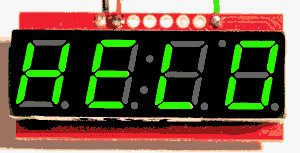

I hope that few people will read this page!
It recounts some struggles I had with a device. I rarely need to struggle with devices from the source concerned, and usually track my problems down to errors made by me.
I've used the device concerned before, doing the same thing I tried to do again 12/18. I don't (yet!) know why I had trouble the second time.
The device is a serially driven 4 character LED display, with the characters each created by 7 segments, from Sparkfun.com.
I have another page, a main page, about the Sparkfun serially driven 4 characters x 7 segment LED module. If you haven't come here from there, go there before reading the rest of this page. (It will open in a new tab).
I could have sworn that in the past, I happily turned the colon on and off. 12/18, I couldn't "do dots" sensibly, at all.
The command I thought would turn just the colon on DID turn it on.... but also some other dots. As far as I noticed, always the same dots. But they shouldn't have come on with the command I issued.
Worse: Once some dots were on, I couldn't turn them off except by cycling the power to the device.
The misbehavior was consistent, at least.
There is a command to turn colon, decimal points, the apostrophe on or off, selectively, in any combination. Excellent. I was just not able to get it to work, 12/18.
I couldn't even get the dots I'd turned on off again with the general "clear display" command...
The clear display command performs two functions:
Clear the display - all LEDs, including segments and decimal points, are turned off.
Reset the cursor to position 1, the left-most digit.
The clear display command byte is 0x76
That comes from one page of the well written wiki about using the Sparkfun serially driven 4 character (7 segment) LED display.
In passing.... I believe that "0x76" is the ASCII code, in hex, for "v". I just sent "v" to the display previously. And it worked to clear the digits, even if the dots stayed on. But, in quick... possibly flawed... trials, 12/18, sending 0x76 didn't work for me.
I was using an old Sparkfun LED display. The predecessor of the one they now sell. But it was that one I wrote my other essay, my "How to use Sparkfun LED display" with. And, as far as memory and study serve, the "new" (current 12/18) displays use the same protocols, command sets.
I had the Arduino IDE in a Windows 10 computer. I was programming an Arduino Pro Mini, 5v. Arduino IDE 1.8.5
And remember: I LIKE the device. It works FINE for simple "display some digits".
As usual, if customers will RTFM, there's a lot of Good Stuff in the Sparkfun guide to the device.
They are even willing to admit the possibility... and offer solutions... when things aren't performing entirely to plan.
In the case of the current (12/18) display, there are some remarks in the guide just quoted, to the effect that if you try to do certain arcane things, some instances of the new display, presumably just one batch? may not "play nicely" in the arcane fields. But! There is a cure! Apparently, you can replace the code in the device. Whew! (I still hope it won't be something I have to do!) And wasn't it good of them to be "up front" with the possible nuisance?)
Remember: I was working with an old component. Maybe what I was having trouble with is no longer an issue. And in any case, the module is fine for many jobs. But if you, too, tried to play with the dots, I hope the above was at least consolation, if not "an answer".
![]() Page tested for compliance with INDUSTRY (not MS-only) standards, using the free, publicly accessible validator at validator.w3.org
Page tested for compliance with INDUSTRY (not MS-only) standards, using the free, publicly accessible validator at validator.w3.org
....... P a g e . . . E n d s .....